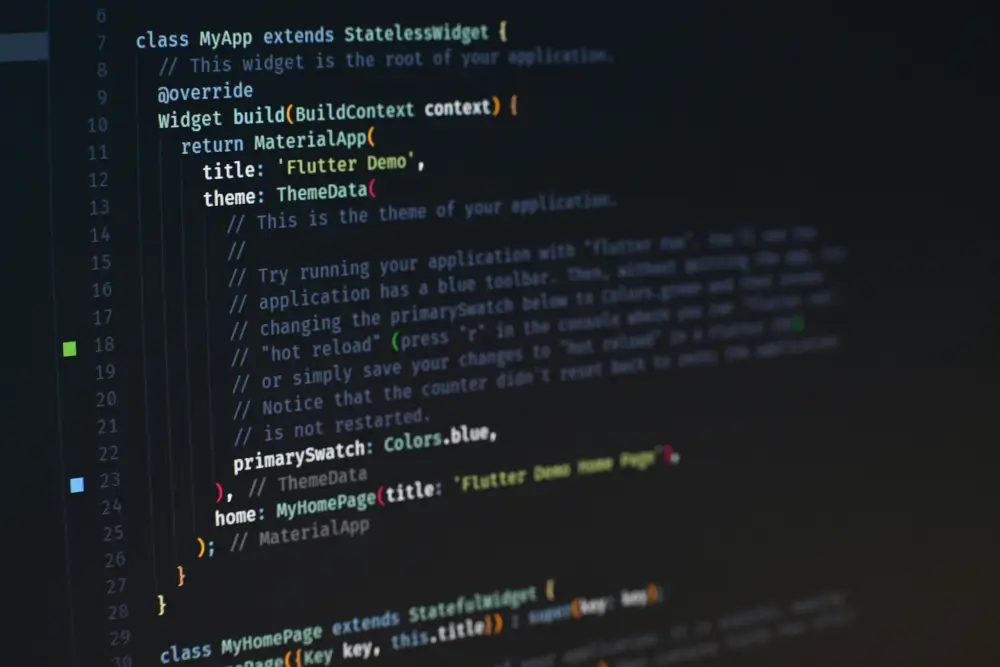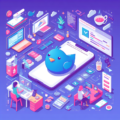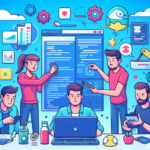Key Takeaways: This case study highlights the importance of thorough preparation, willingness to adapt, and the benefits of embracing Flutter’s strengths. The result was a more efficient development process, a higher-performing app, and an overall positive impact on the business.
Migrating an app to a new framework can be a pivotal decision for any development team. With the tech world rapidly evolving, choosing the right framework is crucial for long-term success. Flutter, with its unique features and growing popularity, stands out as a strong candidate for app migration.
In your quest to enhance your app’s performance and user experience, you might be considering Flutter as your go-to framework. The promise of a single codebase for both iOS and Android platforms is certainly enticing, but how do you ensure a smooth transition?
In this article, you will learn:
- The compelling reasons why Flutter is becoming a preferred choice for app migration.
- A comprehensive guide to navigating the migration process efficiently.
- Strategies to overcome common challenges encountered during the migration.
Let’s dive into the world of Flutter and explore how it can redefine the capabilities of your app.
Why Migrate to Flutter?
Flutter is not just another framework in the crowded space of mobile app development; it’s a game-changer. As developers and businesses seek to streamline their operations and improve their apps, Flutter emerges as a powerful solution. But what exactly makes Flutter stand out?
Firstly, Flutter’s single codebase architecture is a major draw. It enables developers to write one set of code for both iOS and Android platforms, significantly reducing development time and resources. This cross-platform efficiency doesn’t come at the cost of performance either. Flutter apps are known for their smooth and native-like performance, owing to Flutter’s own rendering engine.
Another compelling reason to migrate is Flutter’s customizable widget sets. These widgets allow for creating visually attractive and responsive user interfaces. The level of UI customization goes beyond what many other frameworks offer, giving developers the freedom to bring their creative visions to life.
Furthermore, Flutter’s growing community and support from Google ensure continuous improvement and updates. This robust community support translates into a wealth of resources, from troubleshooting guides to innovative plugins, making the development process more manageable and up-to-date.
As we delve deeper into the topic of migrating your app to Flutter, it’s essential to have a clear understanding of how Flutter stands in comparison to other popular technologies in the app development landscape. This comparison is crucial because it helps you make an informed decision, ensuring that your migration to Flutter aligns with your specific needs and goals.
The following table provides a comprehensive comparison between Flutter and its key competitors across various critical aspects of app development. These aspects include the learning curve, user interface design, performance metrics, available libraries and packages, platform compatibility, app maintenance requirements, development features, backend integration options, as well as their respective advantages and disadvantages.
By examining this table, you will gain insights into the unique strengths and potential limitations of Flutter compared to other technologies. This knowledge is invaluable as it sets the stage for understanding why migrating to Flutter could be a strategic move for your app development process, especially in terms of efficiency, performance, and cross-platform compatibility.
Let’s take a look at the table to better appreciate Flutter’s position in the current tech ecosystem before moving forward with our discussion on migrating to Flutter.
| Topic | Flutter | Others | Example |
|---|---|---|---|
| Learning Curve | Uses Dart, known for simplicity and readability. Widget-based development is intuitive. | Often use languages like JavaScript, advantageous for those already familiar with these languages. | React Native, Xamarin, Ionic |
| User Interface | Own UI components (widgets) for consistent look across platforms. Offers customization. | Typically use native UI components for a more native look and feel but may require platform-specific code. | React Native, Xamarin, Ionic |
| Performance | Compiles to native machine code, enhancing performance. Own rendering engine (Skia) provides features and customization. | Might use JavaScript engines; performance can depend on the platform/device due to reliance on a JavaScript bridge. | React Native, Xamarin, NativeScript |
| Libraries and Packages | Growing collection, expanding as more developers contribute. Fewer options compared to mature ecosystems. | Often have a larger and more diverse ecosystem, leveraging existing JavaScript libraries but might face issues with quality and compatibility. | React Native, Ionic, Cordova |
| Platform Compatibility | Supports iOS, Android, Web, Windows, macOS, Linux. Consistent across platforms but requires customization for native styles. | Primary support for iOS and Android, with varying support for other platforms. Uses native UI components for automatic platform adaptation. | React Native, Xamarin |
| App Maintenance and Updates | Generally requires less effort; more isolated from external factors affecting stability. Updates and testing can be done simultaneously across platforms. | Might require more attention to external platform updates and changes. Maintenance can vary depending on the framework’s reliance on external libraries. | React Native, Ionic |
| Development Features | Offers faster development with hot-reloading, seamless integration with existing code, and rich widgets. | Features like hot-reloading, native rendering, and intelligent debugging tools. Example: React Native allows adding new codes directly into a live app. | React Native, Xamarin |
| Backend Integration | Compatible with backends like Backendless and Firebase, offering real-time databases, user authentication, and scalability. | Can integrate with various backend solutions and leverages a rich ecosystem for backend integration. | React Native, Ionic |
| Disadvantages | Issues with vector graphics and animation rendering, limitations in UI rendering on native platforms, later introduction of native features. | May have performance issues, reliance on third-party libraries, and platform-specific challenges. | React Native, Ionic |
| Notable Apps | Google Ads, Alibaba, eBay, Reflectly. | React Native – Facebook, Instagram, SoundCloud, Walmart. | React Native, Xamarin, Ionic |
In summary, the decision to migrate to Flutter is backed by its:
- Unified codebase for iOS and Android.
- High-performance benchmarks.
- Extensive UI customization options.
- Strong community and ongoing support.
In the next section, we will delve into how to prepare for your app’s migration to Flutter, setting the stage for a successful transition.
Preparing for Migration
Migrating your app to Flutter is a strategic process that requires careful planning and consideration. Before diving into the technicalities, it’s crucial to lay a solid groundwork to ensure a smooth transition. Here’s how to get started:
Assessment of Your Current App: Begin by thoroughly analyzing your existing app. Understand its architecture, features, and the technologies used. This step is vital to identify the elements that will be straightforward to migrate and those that might need more attention or a complete overhaul.
Planning Your Migration: Migration is not an overnight task. It requires a detailed plan with a realistic timeline. Consider the size and complexity of your app, and allocate resources accordingly. This plan should include time for learning Flutter, coding, testing, and potential troubleshooting.
Key Considerations: Before initiating the migration, ponder upon these key aspects:
Team’s Expertise:
Ensure that your team is equipped with or has access to Flutter development skills. If not, consider training your existing team or bringing in Flutter experts.
Dependencies and Integrations:
Evaluate your current app’s dependencies and third-party integrations. Check for their compatibility with Flutter or look for alternatives within the Flutter ecosystem.
Testing Strategy:
Plan how you will test the migrated app. Flutter provides excellent testing frameworks, but it’s crucial to have a strategy in place to test both the old and new components during the migration.
Preparation is half the battle in migration. With a solid plan and a clear understanding of your current app, you’re set to embark on a successful migration journey to Flutte
The Migration Process
Successfully migrating an app to Flutter involves several steps, each crucial to ensure the new app’s functionality and performance match or exceed the original. Let’s break down this process:
Initial Setup and Environment Configuration:
Start by setting up the Flutter development environment. This includes installing Flutter SDK, setting up your preferred IDE (like Android Studio or VS Code), and configuring necessary tools and plugins.
Code Conversion:
Begin the process of converting your app’s codebase to Dart, Flutter’s programming language. This step is not just about translating code but also about adapting to Flutter’s paradigms and architecture, such as widgets and state management.
UI/UX Adjustments:
One of Flutter’s strengths is its rich set of customizable widgets. Utilize these to recreate or enhance your app’s user interface. Pay special attention to ensure the UI is intuitive and maintains consistency across different platforms.
Data Management and State Handling:
Efficient data management and state handling are key to a responsive app. Implement Flutter’s recommended practices for managing app data and states, ensuring smooth and dynamic user experiences.
Integrating Dependencies:
Integrate necessary libraries and plugins. Flutter’s ecosystem is rich with packages and plugins, but always verify their compatibility and performance before integration.
Testing and Quality Assurance:
Rigorous testing is crucial. Utilize Flutter’s testing features for unit, widget, and integration tests. Ensure that the app functions correctly across different devices and scenarios.
Deployment and Monitoring:
Once satisfied with the testing, deploy the app. Post-deployment, monitor the app for any unforeseen issues and gather user feedback for future improvements.
Remember, migration is not just a technical challenge but also an opportunity to refine and improve your app. Embrace Flutter’s capabilities to enhance your app’s performance, usability, and appeal.
Common Challenges and Solutions
Migrating an app to Flutter can come with its unique set of challenges. Being prepared for these obstacles and knowing how to address them is key to a successful migration. Let’s explore some common challenges and their solutions:
Learning Curve for Dart and Flutter:
Transitioning to a new language and framework can be daunting. The solution lies in investing time in learning and training. Utilize resources like Flutter’s official documentation, online courses, and community forums to accelerate the learning process.
Handling Dependencies and Third-Party Libraries:
Not all native libraries and dependencies may have a direct equivalent in Flutter. To overcome this, search for alternative packages in the Flutter ecosystem or consider creating custom plugins.
Performance Optimization:
Flutter is known for its performance, but improper use can lead to issues. Optimize performance by following best practices like efficient state management, using const widgets where possible, and profiling the app regularly.
Maintaining a Consistent UI Across Platforms:
Flutter excels in creating a consistent UI across platforms, but it requires careful design planning. Ensure you regularly test on both iOS and Android to maintain a uniform look and feel.
Complex State Management:
As apps grow, managing state becomes more complex. Explore Flutter’s state management solutions like Provider, Riverpod, or Bloc, and choose one that best fits your app’s needs.
Integration Testing:
Ensuring that the migrated app works as expected is crucial. Employ Flutter’s integration testing tools to automate testing across different devices and scenarios.
By anticipating these challenges and preparing solutions, you can navigate the migration process more smoothly and efficiently.
Case Study: A Successful Migration to Flutter
To illustrate the potential of a successful Flutter migration, let’s examine a real-world example. [Note: The following case study is hypothetical and serves to demonstrate key points.]
Background: A popular e-commerce app, initially built using a native framework, faced challenges with maintaining two separate codebases for iOS and Android. The development team was stretched thin, updates were slow, and the app’s performance was lagging on older devices.
The Migration Decision: The team decided to migrate to Flutter, attracted by its promise of a single codebase, improved performance, and dynamic UI capabilities.
Process and Challenges: The migration process involved:
- Rewriting the app in Dart, which initially slowed down the team due to the learning curve.
- Redesigning the UI using Flutter’s widgets, which allowed for more creative and responsive designs.
- Overcoming the challenge of integrating specific native features by creating custom plugins.
Outcomes:
Post-migration, the app saw significant improvements:
Development time for new features was halved.
Performance increased, particularly on older devices, leading to better user reviews.
The team was able to quickly iterate and push updates simultaneously for both platforms.
Migrate Your App to Flutter with SAYGE: The Experts You Need
Now that you’re equipped with a thorough understanding of the migration process to Flutter, you might be contemplating the next steps. While knowledge is power, executing a successful migration is a whole different ballgame. This is where SAYGE, your Flutter migration experts, come into play.
Start Your Migration Journey with SAYGE
At SAYGE, we make starting with Flutter not just possible, but a breeze. Our approach is tailored to support you and your team every step of the way. From evaluating your existing app to developing a strategic migration plan, and even piloting your first Flutter project, we’re here to ensure a seamless transition.
Tailored Migration Strategies
Understanding that every app and goal is unique, we offer different types of migrations:
Complete Migration to Flutter:
Ideal for a complete relaunch or significant design overhaul, this approach involves migrating the entire application to Flutter. It’s perfect for those looking to revamp core functions or update the design, minimizing future maintenance efforts.
Step-by-Step Migration to Flutter: Suited for massive applications or new feature introductions, this gradual approach allows for feature-by-feature migration. It’s especially beneficial if your team is new to Flutter, easing them into the ecosystem without overwhelming them.
Our Proven Migration Process
Evaluation:
We start by closely examining your app, understanding its intricacies to develop a foolproof migration strategy.
Proof of Concept:
Next, we create an initial version of your app with a scalable architecture, offering you an immediate glimpse into the potential of your Flutter app.
Team Training:
Finally, we don’t just hand over the app; we ensure your team is well-trained and comfortable with Flutter, using your own app as the training ground.
The SAYGE Advantage
Choosing Flutter, you’re opting for a future-proof, high-performance, cost-effective, and easy-to-maintain framework. And with SAYGE, you’re not just choosing a service provider; you’re selecting a partner who’s invested in making your transition to Flutter as smooth and efficient as possible.




